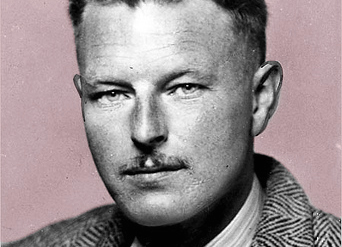
Malcolm Lowry writes to friend, poet, and novelist Conrad Aiken from Oslo.
Hotell Parkheimen
Drammensveien 2, Oslo
[September 1931]
Hi there, Colonel Aiken—
SS Fagervik[1]—oh which, curiously, very many happy memories—has been laid up & I am here waiting a few days for another ship. It is a small place; but the smallest place in it, up in the mountains, is called Frognersæteren.[2] The language is quite fantastic & driven into myself, I do little else but read Tauchnitz editions;[3] and so doing I have discovered one first rate author, an American, Julian Green, who writes in French, which is translated back again into English.[4] So.
My writing has changed—my hair is going gray—I enclose you a poem about ducks which is in the Tauchnitz anthology of English poetry & American authors![5] Take it to the Ship Inn with you if you are in Rye, order a half quartern—& I beg of you to drink my health—& have a good laugh! And there’s another one by Gerald Gould, too.[6]
Once I could play panjo fine—
Nobody speaks English here, & in the only conversation I have had about literature I was surprised to discover that the most famous English writer here was Gibson. As the conversation progressed I noticed that somehow they’d got his Christian name wrong, Henry instead of Wilfrid.[7] I pointed this mistake out, & seeing my chance which I had been waiting for all this time, I told, stumblingly, your famous story about Frost & Gibson at the English fair. They were astonished at the irrelevance of this because, as I later discovered, they were talking all this while about Henrik Ibsen—[8]
Is that funny?
It is perfectly false—I have just made it up.[9]
Anyhow,
Heaps of
Love.
Maltz.
[The following parody of Munch was enclosed in the letter]

From Sursum Corda! The Collected Letters of Malcolm Lowry, Volume One: 1926-46.
Edited by Sherrill E. Grace. Toronto: University of Toronto Press. pgs 110-111.
[1] Lowry sailed to Norway on the SS
Fagervik in the hope of meeting Nordahl Greig
[2] Frognersæteren is today a suburb of Oslo and a mere thirty minutes by tram from downtown. It is located on a hill overlooking the city.
[3] Baron Christian Bernhard von Tauchnitz (1816-1895) was the founder of a publishing house in Leipzig that began issuing an English-language collection of British and American authors in 1841.
[4] Julien Hartridge Green (1900-1998), the Paris-born American writer, was christened ‘Julian’ but chose to use the French spelling of his name. Over a long and distinguished career he has published many novels and plays, nine volumes of his journals, and seven autobiographies, and he was the first foreigner elected to the French Academy. Lowry owned
The Dark Journey (1929), which is mentioned in
Dark as the Grave Wherein my Friend Is Laid and referred to in early drafts of
Under the Volcano, and he continued to be an admirer of Green’s work.
[5] Lowry is referring to F.W. Harvey’s poem ‘Ducks’ in the
Anthology of Modern English Poetry, selected by Levin L. Schücking (Leipzig: Bernhard Tauchnitz, 1931), vol. 5000, pp.120-23. This light-hearted poem concludes with the line: ‘And He’s [God] probably laughing still at the sound that came out of its bill!’ Lowry’s copy of the poem is not extant with this letter.
[6] Gerald Gould (1885-1936) was a British journalist, poet, and critic. He had two poems in the 1931 Tauchnitz anthology that Lowry was reading: ‘Alien Evemies’ (116-118) and ‘Wander-Thirst’ (119).
[7] Wilfrid Wilson Gibson (1878-1962) was a British poet and playwright also represented in the 1931 Tauchnitz anthology. Aiken’s ‘famous story’ concerns a trip made by Gibson and the American poet Robert Frost to an English fair in 1915. Gibson felt he had wasted his day because he found nothing to write about.
[8] Henrik Ibsen (1828-1906), the Norwegian playwright, is often referred to by Lowry in subsequent letters.
[9] Lowry’s drawing of
The Shriek after Edvard Munch’s famous lithograph
Gescrei (1895) is on the verso of the letter. The painting on which the lithograph is based was done in 1893, and the image began to be discussed and reproduced as early as 1896.




